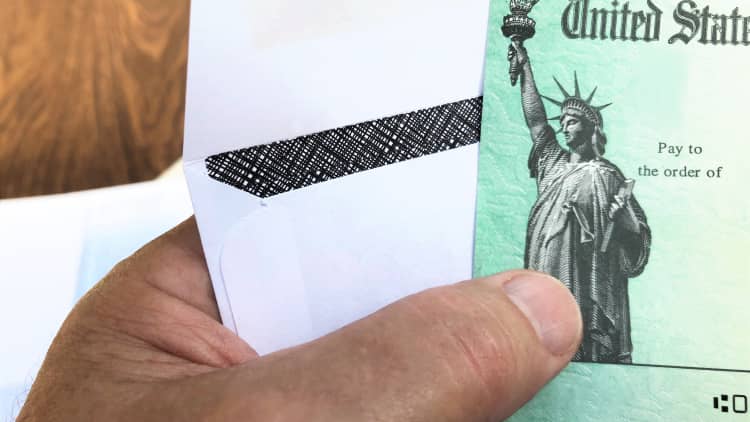As Social Security faces shortfall, some propose investing in stocks
Wand_prapan | Istock | Getty Images
The trust funds that Social Security relies on to pay benefits are “rapidly heading to zero,” according to the Center for Retirement Research at Boston College.
Those funds, which are typically invested in Treasury securities, are projected to run out in 2034, at which point just 80% of benefits may be payable.
As that date draws closer, that has prompted more discussion as to whether that money should also be invested in stocks.
“Theoretically, yes,” said Anqi Chen, senior research economist and assistant director of savings research at the Center for Retirement Research, which recently published research addressing the question.
More from Personal Finance:
Here’s what happens to Social Security benefits after you die
As student loan bills resume, how economy may be shaken
How Congress may fix looming Social Security benefit shortfall
But the real-world answer is not necessarily clear-cut, Chen and other experts say.
The problem is whether the funds, which are already running low, may be able to come up with the money to invest in stocks while also paying the benefits it owes.
Those benefit obligations are growing as baby boomers age, with 10,000 individuals turning 65 every day.
There were 53 million Social Security beneficiaries in 2010, the year before baby boomers started turning 65, according to the Peter G. Peterson Foundation in New York, which focuses on fiscal and economic challenges facing the U.S.

This ‘big idea’ fix would rely on stocks
Sen. Bill Cassidy, R-La., has put forward another “big idea” fix that calls for investing money in stocks on the program’s behalf.
The proposal calls for raising $1.5 trillion that would be put in a separate fund and invested in stocks.
No Social Security trust fund dollars would be included in the plan. Instead, the separate $1.5 trillion investment fund may come from either borrowing the money, raising the funds from other parts of the budget or by selling government assets.
The investment would be held in escrow for 70 years, which would allow the funds to grow.
It always will have enough revenue coming in from the investments to pay scheduled benefits.
Sen. Bill Cassidy
Republican U.S. senator from Louisiana
Over time, the investment fund would get a higher return than the returns on Treasury notes, ranging from 1% to 4%, which may not beat inflation, Cassidy noted at a recent AARP forum of the future of Social Security.
Ultimately, 75% of Social Security’s deficit may be covered by the strategy, while it would be up to lawmakers to come up with a strategy to make up the difference.
“Never again will we worry about a Social Security shortfall,” Cassidy said at the AARP event. “It always will have enough revenue coming in from the investments to pay scheduled benefits.”
How government retirement funds use equities
1. Cassidy’s plan takes inspiration from other countries, including Canada:
- The Canada Pension Plan, with about $570 billion in Canadian dollars, changed its investment approach in 1997 in response to the need for higher payroll contributions due to longer life expectancies, lower birth rates and lower real wage growth, according to the Center for Retirement Research. The plan raised payroll contributions and began investing some funds in equities. Now its portfolio includes a variety of investments, including stocks, bonds, real estate, infrastructure projects and private equity. The fund, which invests in Canada and globally, has had a 10% annualized net return over the past 10 years.
2. Certain U.S. programs have also implemented investments that incorporate stocks:
- In the 1990s, the U.S. Railroad Retirement System moved to invest in equities after its trust fund grew to four times annual spending, according to the Center for Retirement Research. The portfolio, now with around $27 billion in net assets, includes stocks, real estate, private equity and private debt.
- The Federal Thrift Savings Plan, with about $800 billion in assets, was created in 1986 and includes passive investments through index funds. Congress must approve the investments it can offer.
Financial industry experts who have evaluated the plan have said the return expectations are conservative and would have a negligible effect on the equity market, according to Molly Block, a spokeswoman for Cassidy.
Why experts are cautious
zimmytws | iStock | Getty Images
While it would be up to Congress to approve any changes to Social Security’s investment strategy, experts question the inevitable risks.
Generally, one of the prerequisites for investing Social Security in stocks is having the money to do it. In the 1990s and 2000s, when the idea was previously discussed, the trust funds had more money available to invest, according to Chen.
Now, there may have to be a tax increase to not only shore up Social Security’s current funding shortfall, but also provide additional funds to be invested in equities.
“Theoretically, yes that could work,” Chen said. “But that seems politically very difficult.”
Borrowing money to invest in stocks for retirement is a risky move, regardless of whether it’s in an individual’s 401(k) plan or a government retirement plan, noted Andrew Biggs, senior fellow at the American Enterprise Institute.
“It’s basically taking a bet on stocks versus bonds,” Biggs said. “It’s not smart for an individual to do it, and we’re doing it on an economy-wide basis.”
Moreover, while a 4% or 5% risk premium can make a big difference over a 30-to-50-year time horizon, there’s no guarantee those terms won’t change along the way, which could interfere with Social Security as a guaranteed government program, noted David Blanchett, managing director and head of retirement research at PGIM DC Solutions.
“It’s just not realistic to expect that things wouldn’t change in the interim,” Blanchett said. “I’m incredibly apprehensive about the idea of investing Social Security type benefits in public equity funds.”
[ad_2]
Source link


